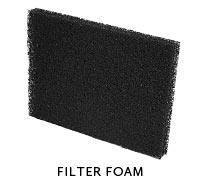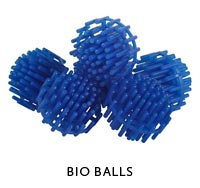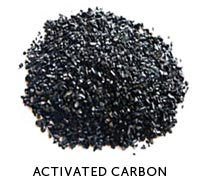Introduction to Aquarium Filtration
Both freshwater and marine aquaria need aquarium filters. Physical and soluble chemical waste can accumulate in aquaria and aquarium filters help remove these wastes. Most fish accustomed to their natural environments will not be able to survive in aquaria without the help of aquarium filters because they are not used to the small water volume.
In a small, confined volume of water, there is no waste dilution system that happens in the natural aquatic environment. Whether you have a large tank or a small one, you will still need a filtration system to keep the fish healthy and alive. Toxic ammonia can be a serious problem and you cannot keep changing the water as often as it needs to be changed.
 Water in aquaria has a tendency to become contaminated due to uneaten plant food and waste from excrement.
The health of aquaria can be in jeopardy if contamination level is too high. For healthy aquaria maintenance, Filtration procedures are employed which help remove contamination.
There are three main types of aquarium filtration procedures available:
Water in aquaria has a tendency to become contaminated due to uneaten plant food and waste from excrement.
The health of aquaria can be in jeopardy if contamination level is too high. For healthy aquaria maintenance, Filtration procedures are employed which help remove contamination.
There are three main types of aquarium filtration procedures available:
Mechanical Filtration
 Mechanical filtration is the straining of solid waste particles from the aquarium water.
To limit the production of ammonia in aquarium water, you need to limit the filter waste products before they get a chance to decay.
Decay is not only very dangerous because it causes high levels of ammonia in the fish water but it is also something that gives your aquaria a bad appearance.
Mechanical filtration is the straining of solid waste particles from the aquarium water.
To limit the production of ammonia in aquarium water, you need to limit the filter waste products before they get a chance to decay.
Decay is not only very dangerous because it causes high levels of ammonia in the fish water but it is also something that gives your aquaria a bad appearance.
Fish gills can also produce ammonia as a waste matter, as do fish excretions. Fish food rotting away can have the same effect. Mechanical filters are designed in a way that they will not remove microscopic bacteria and algae and they also won't remove any solids trapped by gravel or your decorations. They have no effect on dissolved ammonia either. Mechanical filtration media include bonded floss media which have the largest openings, loose floss media, as well as paper cartridges which have the smallest openings and clean sponges.
To certain degrees these items are reusable. Finer particles may be easier to catch with small openings of a filter media but they can also become clogged. The idea is to have a mechanical filter that traps enough solids to keep the water clear without frequent plugging. A large filter area clogs slower than a small filter. Smaller and smaller particles are trapped when filter media gets dirty until it can no longer pass water.
Biological Filtration
 To build a successful aquarium you need nitrogen cycle management and to do that you need to foster essential bacteria growth.
Ammonia produced as a result of excretion and decomposition of organic matter can become toxic and fish will not be able to survive in it.
Ammonia needs to be first broken down into nitrites which are less toxic and then into nitrates.
To build a successful aquarium you need nitrogen cycle management and to do that you need to foster essential bacteria growth.
Ammonia produced as a result of excretion and decomposition of organic matter can become toxic and fish will not be able to survive in it.
Ammonia needs to be first broken down into nitrites which are less toxic and then into nitrates.
This breaking down takes places when bacterial processes oxidize ammonia. The idea is to produce nitrates which can be taken up by plants thriving in the environment as fertilizer but the problem is that most aquarium environments are not replicas of natural environments. You may have more fish producing ammonia than you have bacteria and plants. The small volume of a fish aquarium actually has higher ammonia levels than anywhere else.
Bacteria required for biological breakdown of ammonia grow on surfaces within the aquarium. Using a biological filter in such a situation can be very helpful. This filter uses a chemically inert porous sponge so bacteria can develop on the massive surface area. A biological filter is necessary when you have a large quantity of fish. Biological filters increase the capacity of the bacteria colony and increase the available oxygen dissolved in the water.
Chemical Filtration
 The removal of dissolved wastes from aquarium water is known as chemical filtration.
At the molecular level, Polar and Non-polar dissolved wastes can exist in aquaria.
There are several methods through which these wastes can be removed.
The process of chemical filtration can be achieved by filtering the aquarium water through gas activated carbon or through protein skimming.
Activated carbon works for non-polar wastes while protein skimming is ideal for polar wastes.
The removal of dissolved wastes from aquarium water is known as chemical filtration.
At the molecular level, Polar and Non-polar dissolved wastes can exist in aquaria.
There are several methods through which these wastes can be removed.
The process of chemical filtration can be achieved by filtering the aquarium water through gas activated carbon or through protein skimming.
Activated carbon works for non-polar wastes while protein skimming is ideal for polar wastes.
When coal is warmed in the presence of steam at very high temperatures the carbon develops huge numbers of tiny pores which is known as Granular activated carbon (GAC). GAC causes the non-polar wastes to be trapped by processes of adsorption and ion exchange. Through the process known as molecular sieving, GAC also removes heavy metals and organic molecules in water. These molecules give the water smells and colors you don't need in an aquarium setting.
This form of macroporous activated carbon is not as dense as GACs used to filter air and that is why they float in water. Phosphate leaching from GACs is a problem which can become a hurdle for reef aquaria and that is why activated carbon should only be bought from reliable companies. These manufacturers give the GACs an acid wash which to minimize ash content to attain lower phosphate leaching levels. These GACs will also keep the aquarium water safe from pH shifts of any kind. Presoaking your activated carbon for a few weeks before use can further lower the risk of phosphate leaching.
In order to remove specific chemicals, special chemical filtration media have been developed like zeolite clay removes ammonia from aquarium water but it will disrupt or delay the establishment of natural biological filtration. This is why this particular filtration media should be used only for short periods of time and is not a long term solution. For saltwater aquaria like reef, protein skimmers work best. The way it works is by removing dissolved organic wastes before decomposition takes place. The polar nature of the organic molecules will cause air bubbles and the foam that forms as a result can be skimmed off.